#tutcetus
Text
Tutcetus: Dwarf Basilosaurid
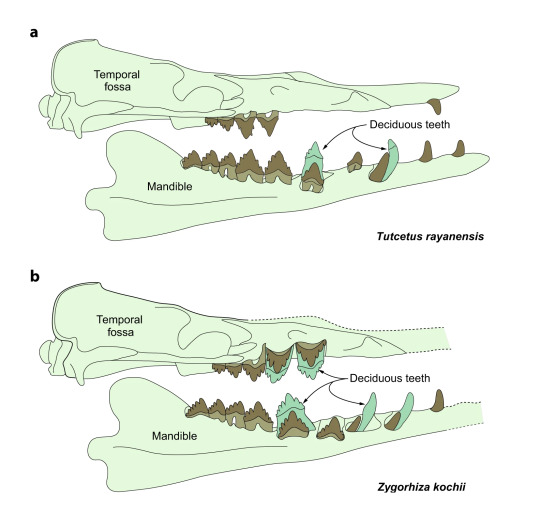

It's funny, barely a week after the reveal of Perucetus, perhaps the largest known basilosaurid so far, we immediately see the description of what may be the smallest.
Tutcetus, named after child king Tutankhamun, is a new species of early whale that may have measured only 2.5 meters. Known from a single skull of what is thought to be a subadult at the very edge of maturity, it is also one of the oldest basilosaurids. The fossil was discovered in the famous Fayum Depression, i.e. one of the most important regions for early whale fossils.
While its generally hard to tell age, the stage of tooth replacement and the fusion of the skull bones indicate that Tutcetus was about to reach maturity, so it likely didn't grow much larger than indicated by the holotype fossil.
Tutcetus seems to be an early diverging basilosaurid (which is paraphyletic according to the authors), with its closest relatives being Ocucajea (a contemporary of Perucetus) and Chrysocetus.
Although our sample size is obviously low, the authors still tried their best to deduce some parts of its biology. For instance, they suggest that the small size of this animal might be related to the warmer temperatures of its time and that Tutcetus followed the mantra of "live fast, die young". They argue that Tutcetus, again based on how its teeth were replaced, matured quickly to reproduce sooner, while never reaching an especially old age. This would contrast later basilosaurids, which would grow slower, reach larger sizes and live longer. But of course more material would go a long way to confirm these suggestions.
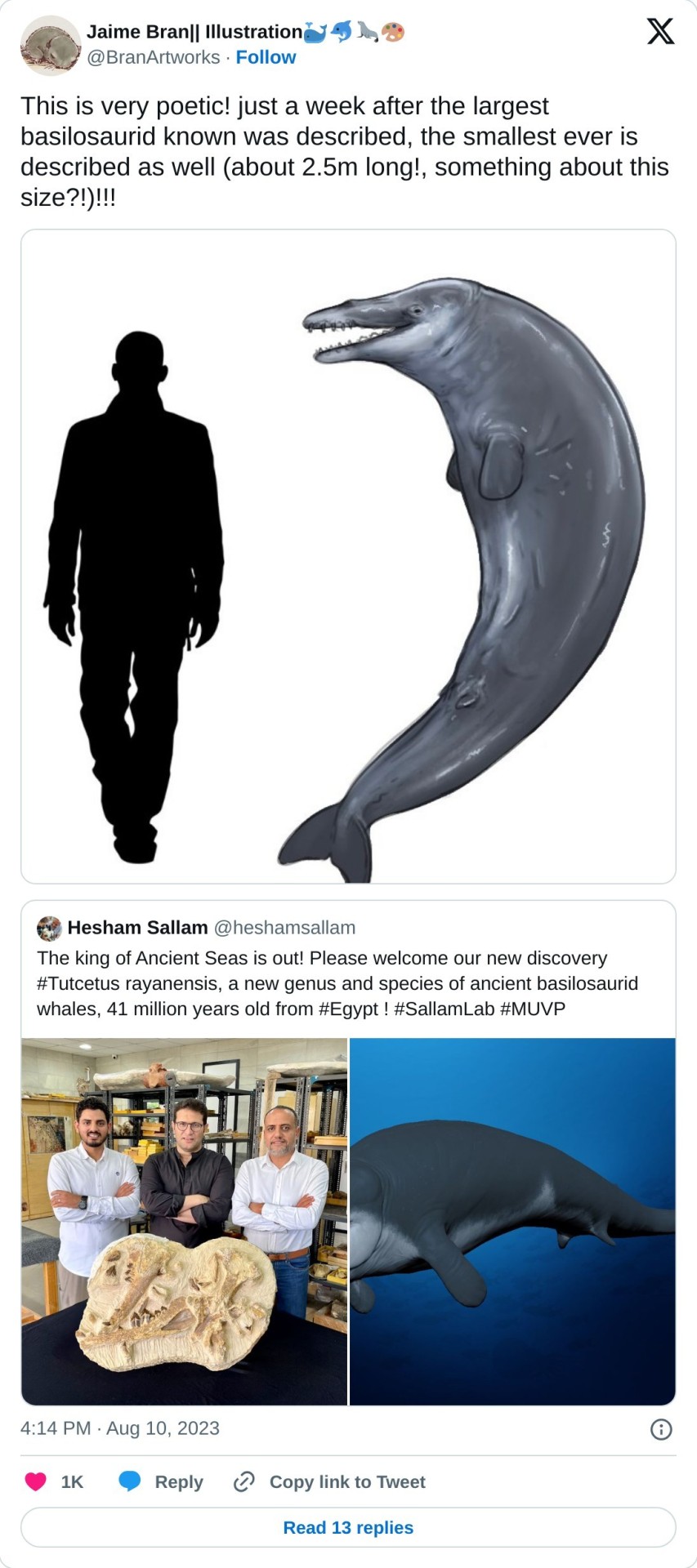
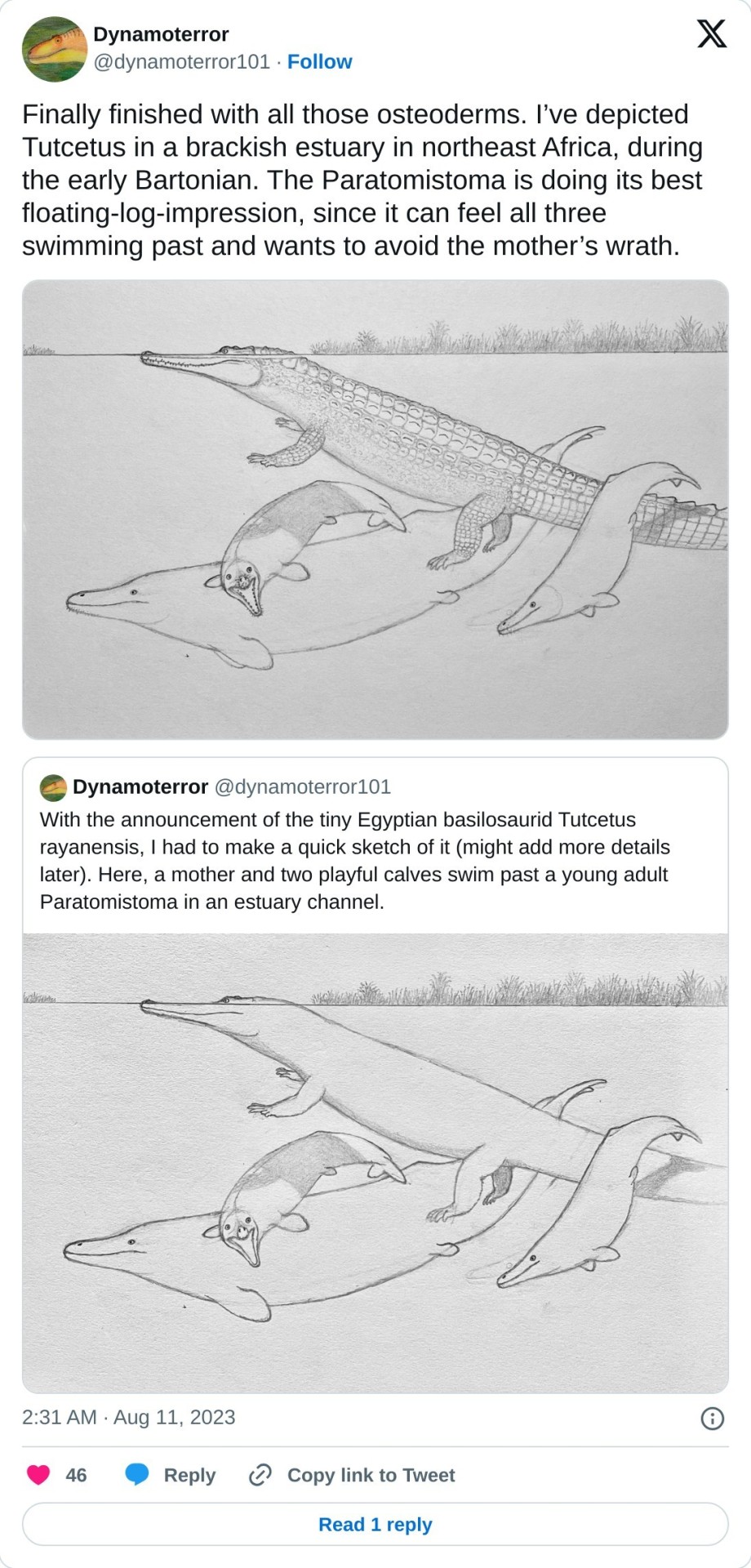
#palaeoblr#paleontology#basilosauridae#whale#cetacean#tutcetus#early whale#evolution#prehistory#eocene#egypt#fossil
587 notes
·
View notes
Text

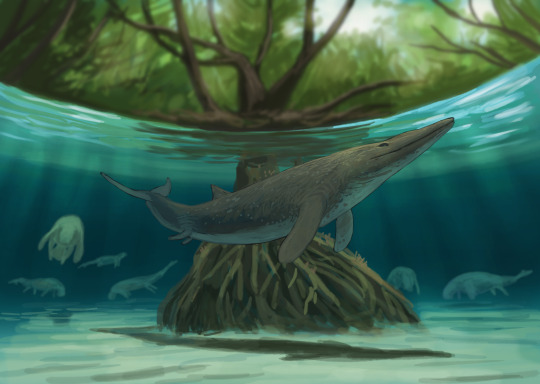
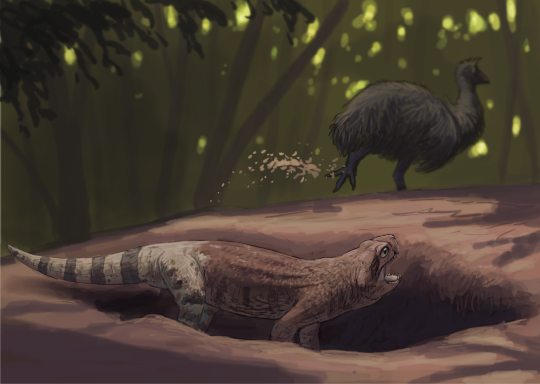
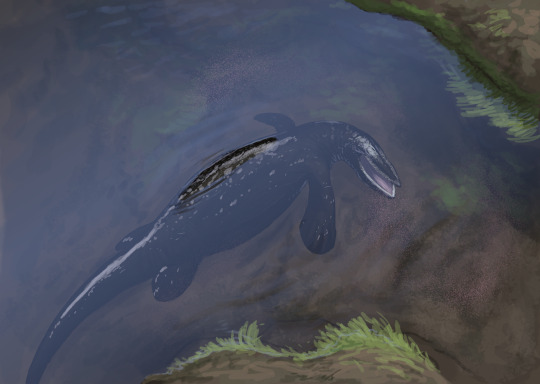
Results from the #paleostream
Arenaerpeton, Tutcetus, Comahuesuchus and Hupehsuchus.
409 notes
·
View notes
Text
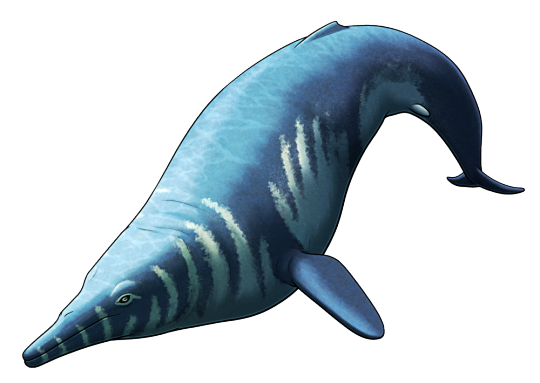
Tutcetus rayanensis was a whale that lived in warm shallow tropical seas covering what is now Egypt during the Eocene, about 41 million years ago.
It was an early member of the "basilosaurids", a grouping made up of multiple early cetacean lineages (an "evolutionary grade") representing some of the first fully aquatic forms. Like other members of this group it probably would have had a rather long and slender body shape – but unlike most of its relatives Tutcetus was comparatively tiny, estimated to only have been around 2.5m long (~8'2").
The fusion of the skull bones in the one known fossil specimen indicate it was almost fully grown at the time of its death, and the pattern of tooth replacement suggests this small basilosaurid species matured very rapidly – a sort of "live fast, die young" life strategy.
Tutcetus' small size and early demise also inspired its genus name, with "Tut" referencing the teenage Egyptian Pharaoh Tutankhamun.
———
NixIllustration.com | Tumblr | Patreon
#science illustration#paleontology#paleoart#palaeoblr#tutcetus#basilosauridae#cetacean#whale#artiodactyla#ungulate#mammal#marine mammals#art
363 notes
·
View notes
Text
Another impression of the giant Archaeocete Perucetus colossus, with the cow-sized Tutcetus and a frogman for comparison. The Archaeocetes of the Eocene surely came in all sorts of shapes and sizes, didn’t they?

66 notes
·
View notes
Text
Perucetus colossus and Tutcetus rayanensis, two basilosaurids on opposite ends of the size spectrum.

#perucetus#tutcetus#basilosauridae#cetaceans#whale#paleoart#pencil drawing#pencil doodle#pencil doodles
16 notes
·
View notes
Text

ALERT!!! In the wake of the discovery of possibly the biggest prehistoric whale, one of the smallest has just be revealed! (It also is one of the earliest whales that was fully aquatic)
7 notes
·
View notes
Text
#Im sorry but I cant take the name tutcetus seriously#it sounds like the name of a cartoon character#I want to draw a little cartoon whale in a nemes headdress
6 notes
·
View notes
Text
In the span of eight days, we have seen the descriptions of the biggest basilosaurid known (Perucetus colossus) and the smallest (Tutcetus rayanensis)
38 notes
·
View notes
Text
@cairo-top-tours
18 notes
·
View notes
Text
L’équipe a nommé cette baleine "Tutsetus Ryanensis", la première partie du nom relatif à "Toutankhamon", qui était l’un des 18 rois de l’ancienne famille égyptienne
@cairo-top-tours
#cairotoptours
13 notes
·
View notes
Text
A diminutive new basilosaurid whale reveals the trajectory of the cetacean life histories during the Eocene
Published 10th August 2023
A new basilosaurid genus and species, Tutcetus rayanensis, from the middle Eocene of Fayum, Egypt.

Tutcetus rayanensis holotype and line drawing

phylogenetic position of Tutcetus rayanensis
Source:
14 notes
·
View notes
Text

Nearly a week ago, when the tiny Basilosaurid Tutcetus rayanensis was described (very soon after the description of the gigantic Basilosaurid Perucetus), I decided to make a quick sketch of it. Here, I’ve depicted a mother Tutcetus and two young calves swimming through a deep channel in a brackish estuary, in what will one day be northern Egypt in the middle Eocene (early Bartonian to be specific). I couldn’t find much on the contemporary fauna of Tutcetus, so I went with the middle Eocene basal Gavialoid Paratomistoma courti. This individual is a young adult, floating like a log as the whales swim past. With its limbs out, it can sense nearly everything in the water around it with uncanny precision, and it knows not to move a muscle. Two missing fingers on its forelimb attest to a previous, somewhat violent encounter with a Tutcetus, despite this fish-eating croc posing no serious threat to the little whales.
11 notes
·
View notes
Text
Un nuevo descubrimiento en el campo de la paleontología aclara la historia evolutiva de las ballenas
#Travel#tourism#Cairo#Egypt#Pyramids#come_to_Egypt#Tour#Vacation#trip#day tour#cruise#Nile#Luxor#Aswan#Cairo_top_tours
4 notes
·
View notes
Text

While last week's Tutcetus was the smallest known basilosaurid whale, another recently-announced member of that group was almost the complete opposite.
Perucetus colossus was a chonker. An absolute unit of a whale.
Living during the Eocene (~38 million years ago) in shallow marine waters covering what is now the coast of Peru, this ancient whale is known from several vertebrae, ribs, and parts of its pelvis. As a result its full size is uncertain, but based on the proportions of other basilosaurids it was probably somewhere around 17-20m long (~56'-66') – similar in length to the larger specimens of Basilosaurus.
However, it had much thicker denser bones, even more so than those of its close relative Antaecetus, suggesting that its full body mass was much higher than the rather slender Basilosaurus – and possibly heavier than even modern blue whales despite being shorter in overall length.
Perucetus' thickened vertebrae were also fairly inflexible in most directions, indicating it was a sirenian-like slow swimmer with limited maneuverability – but it did have a surprisingly good ability to bend its body downwards. Without skull material it's unclear what its diet was like, but it may have been a suction-feeder hoovering up seafloor prey like modern grey whales or walruses.
I've reconstructed it here with a speculative bristly fleshy downturned snout inspired by the weird skull of Makaracetus, an earlier whale that may have also been a walrus-like bottom-feeder.
———
NixIllustration.com | Tumblr | Patreon
#science illustration#paleontology#paleoart#palaeoblr#perucetus#pachycetinae#basilosauridae#pelagiceti#archaeoceti#cetacean#whale#artiodactyla#ungulate#mammal#art#speculative reconstruction#i am predicting Weird Snoot Shenanigans for this chonkwhale#gotta have some very specialized feeding ecology going on there
394 notes
·
View notes
Text
Licht auf die frühe Walentwicklung und die Rolle Ägyptens werfen
Licht auf die frühe Walentwicklung und die Rolle Ägyptens werfen @cairo-top-tours
6 notes
·
View notes
Text
Découverte du Tutcetus Rayanensis : Lumière sur l'évolution des premières baleines et le rôle de l'Égypte
#cairotoptours
@cairotoptours
3 notes
·
View notes